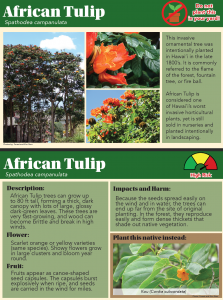Family: Bignoniaceae
Native to Africa, Spathodea campanulata is commonly called African tulip. This ornamental tree was planted widely throughout the state and is now invading many mesic to wet areas. There are naturalization records on all the main Hawaiian Islands. Hillebrand first introduced African tulip to Hawai’i before 1871, with later re-introductions by Joseph Rock in 1915.
In the early 1900s, 30,000 were planted throughout the state for reforestation efforts. Numerous seeds were aerial seeded over the Panaewa and Waiakea areas of Hawaiʻi Island. Now this area is heavily invaded as the climate and rainfall are perfect growing conditions for this invasive tree.
Brittle and soft, the wood has no value for woodworking. It is a dangerous tree to have near homes and roadways because branches break easily. Furthermore, roots from this tree can lift the sidewalk, creating a tripping hazard, and making a dangerous situation.

The tiny wind-dispersed seeds contaminate potted plants. This species is directly threatening Hibiscus brackenridgei ssp. Mokuleianus. The Division of Forestry and Wildlife of the Hawaiʻi Department of Land and Natural Resources has designated this species as one of Hawaiʻi’s Most Invasive Horticultural Plants. African tulip is a ‘no grow’ species for the Big Island Invasive Species Committee (BIISC) Plant Pono program.
Toxic to some pollinators, research indicates this ever-blooming tree is a constant threat to beneficial insects. Deadly nectar pools inside the numerous cup-shaped flowers. Unsuspecting pollinators face a quick death after imbibing the fatal substance. Unable to fly away, they drown inside the insect-killing flower.
Description and Dispersal:
- A tall tree up to 75 ft
- 3-19 leaflets (5 in long by 3 in wide) form the compound leaves
- Scarlet-orange, showy flowers grow in clusters (about 4 in high and 8 in across) year-round; fruit clusters are upright
- Canoe-shaped seed capsules up to 10 in long
- Many small flat seeds are wind dispersed, propagated by cutting and root cuttings
High Risk Traits:
- Highly adaptable to tropical/subtropical climates.
- Naturalized beyond its native range (e.g., Hawaii, Fiji).
- Documented environmental weed that invades mature forests.
- Shade-tolerant, enabling invasion of intact ecosystems.
- Wind-dispersed seeds facilitate long-distance spread.
- Prolific seed producer with extended flowering.
- Resprouts vigorously after cutting or damage.
- Poorly controlled by common herbicides.
Low Risk Traits:
- No spines, thorns, or burrs.
- Not documented as parasitic or allelopathic.
- Not toxic to humans; used for food and medicine.
- Wood is fire-resistant; does not create a fire hazard.




